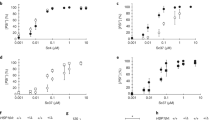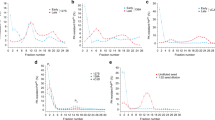Abstract
A remarkable feature of prion biology is the strain phenomenon wherein prion particles apparently composed of the same protein lead to phenotypically distinct transmissible states1,2,3,4. To reconcile the existence of strains with the ‘protein-only’ hypothesis of prion transmission, it has been proposed that a single protein can misfold into multiple distinct infectious forms, one for each different strain1,2,3,5. Several studies have found correlations between strain phenotypes and conformations of prion particles6,7,8,9,10; however, whether such differences cause or are simply a secondary manifestation of prion strains remains unclear, largely due to the difficulty of creating infectious material from pure protein3,5. Here we report a high-efficiency protocol for infecting yeast with the [PSI+] prion using amyloids composed of a recombinant Sup35 fragment (Sup-NM). Using thermal stability and electron paramagnetic resonance spectroscopy, we demonstrate that Sup-NM amyloids formed at different temperatures adopt distinct, stably propagating conformations. Infection of yeast with these different amyloid conformations leads to different [PSI+] strains. These results establish that Sup-NM adopts an infectious conformation before entering the cell—fulfilling a key prediction of the prion hypothesis5—and directly demonstrate that differences in the conformation of the infectious protein determine prion strain variation.
This is a preview of subscription content, access via your institution
Access options
Subscribe to this journal
Receive 51 print issues and online access
$199.00 per year
only $3.90 per issue
Buy this article
- Purchase on Springer Link
- Instant access to full article PDF
Prices may be subject to local taxes which are calculated during checkout




Similar content being viewed by others
References
Prusiner, S. B., Scott, M. R., DeArmond, S. J. & Cohen, F. E. Prion protein biology. Cell 93, 337–348 (1998)
Collinge, J. Prion diseases of humans and animals: their causes and molecular basis. Annu. Rev. Neurosci. 24, 519–550 (2001)
Aguzzi, A. & Haass, C. Games played by rogue proteins in prion disorders and Alzheimer's disease. Science 302, 814–818 (2003)
Chien, P., Weissman, J. S. & Depace, A. H. Emerging principles of conformation-based prion inheritance. Annu. Rev. Biochem. (in the press)
Liebman, S. Progress toward an ultimate proof of the prion hypothesis. Proc. Natl Acad. Sci. USA 99, 9098–9100 (2002)
Bessen, R. A. et al. Non-genetic propagation of strain-specific properties of scrapie prion protein. Nature 375, 698–700 (1995)
Telling, G. C. et al. Evidence for the conformation of the pathologic isoform of the prion protein enciphering and propagating prion diversity. Science 274, 2079–2082 (1996)
Peretz, D. et al. A change in the conformation of prions accompanies the emergence of a new prion strain. Neuron 34, 921–932 (2002)
Chien, P. & Weissman, J. S. Conformational diversity in a yeast prion dictates its seeding specificity. Nature 410, 223–227 (2001)
Chien, P., DePace, A. H., Collins, S. & Weissman, J. S. Generation of prion transmission barriers by mutational control of amyloid conformations. Nature 424, 948–951 (2003)
Uptain, S. M. & Lindquist, S. Prions as protein-based genetic elements. Annu. Rev. Microbiol. 56, 703–741 (2002)
Glover, J. R. et al. Self-seeded fibers formed by Sup35, the protein determinant of [PSI+], a heritable prion-like factor of S. cerevisiae. Cell 89, 811–819 (1997)
King, C. Y. et al. Prion-inducing domain 2–114 of yeast Sup35 protein transforms in vitro into amyloid-like filaments. Proc. Natl Acad. Sci. USA 94, 6618–6622 (1997)
Derkatch, I. L., Chernoff, Y. O., Kushnirov, V. V., Inge-Vechtomov, S. G. & Liebman, S. W. Genesis and variability of [PSI+] prion factors in Saccharomyces cerevisiae. Genetics 144, 1375–1386 (1996)
Kushnirov, V. V., Kryndushkin, D. S., Boguta, M., Smirnov, V. N. & Ter-Avanesyan, M. D. Chaperones that cure yeast artificial [PSI+] and their prion-specific effects. Curr. Biol. 10, 1443–1446 (2000)
Zhou, P. et al. The yeast non-Mendelian factor [ETA+] is a variant of [PSI+], a prion-like form of release factor eRF3. EMBO J. 18, 1182–1191 (1999)
Kochneva-Pervukhova, N. V. et al. [PSI+] prion generation in yeast: characterization of the ‘strain’ difference. Yeast 18, 489–497 (2001)
Uptain, S. M., Sawicki, G. J., Caughey, B. & Lindquist, S. Strains of [PSI+] are distinguished by their efficiencies of prion-mediated conformational conversion. EMBO J. 20, 6236–6245 (2001)
King, C. Y. Supporting the structural basis of prion strains: induction and identification of [PSI+] variants. J. Mol. Biol. 307, 1247–1260 (2001)
Sparrer, H. E., Santoso, A., Szoka, F. C. & Weissman, J. S. Evidence for the prion hypothesis: Induction of the yeast [PSI+] factor by in vitro-converted sup35 protein. Science 289, 595–599 (2000)
Derkatch, I. L., Bradley, M. E., Zhou, P., Chernoff, Y. O. & Liebman, S. W. Genetic and environmental factors affecting the de novo appearance of the [PSI+] prion in Saccharomyces cerevisiae. Genetics 147, 507–519 (1997)
Maddelein, M.-L., Dos Reis, S., Duvezin-Caubet, S., Coulary-Salin, B. & Saupe, S. J. Amyloid aggregates of the HET-s prion protein are infectious. Proc. Natl Acad. Sci. USA 99, 7402–7407 (2002)
Santoso, A., Chien, P., Osherovich, L. Z. & Weissman, J. S. Molecular basis of a yeast prion species barrier. Cell 100, 277–288 (2000)
Chernoff, Y. O. et al. Evolutionary conservation of prion-forming abilities of the yeast Sup35 protein. Mol. Microbiol. 35, 865–876 (2000)
Kushnirov, V. V., Kochneva-Pervukhova, N. V., Chechenova, M. B., Frolova, N. S. & Ter-Avanesyan, M. D. Prion properties of the Sup35 protein of yeast Pichia methanolica. EMBO J. 19, 324–331 (2000)
Baxa, U., Speransky, V., Steven, A. C. & Wickner, R. B. Mechanism of inactivation on prion conversion of the Saccharomyces cerevisiae Ure2 protein. Proc. Natl Acad. Sci. USA 99, 5253–5260 (2002)
DePace, A. H. & Weissman, J. S. Origins and kinetic consequences of diversity in Sup35 yeast prion fibers. Nature Struct. Biol. 9, 389–396 (2002)
Rice, S. et al. Thermodynamic properties of the kinesin neck-region docking to the catalytic core. Biophys. J. 84, 1844–1854 (2003)
McHaourab, H. S., Lietzow, M. A., Hideg, K. & Hubbell, W. L. Motion of spin-labeled side chains in T4 lysozyme: Correlation with protein structure and dynamics. Biochemistry 35, 7692–7704 (1996)
Sondheimer, N. & Lindquist, S. L. Rnq1: an epigenetic modifier of protein function in yeast. Mol. Cell 5, 163–172 (2000)
Acknowledgements
We thank S. Collins, J. Newman, L. Osherovich, K. Tipton and members of the Weissman laboratory for discussion and reading of the manuscript. M.T. was supported by JSPS postdoctoral fellowships for research abroad. P.C. was supported by National Science Foundation Graduate Fellowships and the ARCS foundation. Funding was also provided by Howard Hughes Medical Instititute, The David and Lucile Packard Foundation and the National Institutes of Health.
Author information
Authors and Affiliations
Corresponding author
Ethics declarations
Competing interests
The authors declare that they have no competing financial interests.
Supplementary information
Supplementary Information
Preparation of lyticase (DOC 5 kb)
Supplementary Figure 1
Effects of proteinase K and deoxyribonuclease I on prion infectivity. (JPG 95 kb)
Supplementary Figure 2
Non-Mendelian inheritance of a [PSI+] strain generated by protein infection. (JPG 78 kb)
Supplementary Figure 3
Sedimentation analysis of strong and weak [PSI+] strains generated by protein infection. (JPG 55 kb)
Supplementary Figure 4
Induction of [PSI+] by over-expression of Sup-NM-GFP in [psi-][PIN+] strain. (JPG 44 kb)
Supplementary Figure 5
Induction of prion state by partially purified prion particles derived from strong and weak [PSI+] strains. (JPG 75 kb)
Supplementary Figure 6
Partial proteolysis of Sup-NM fibres formed at 4, 23, or 37°C. (JPG 51 kb)
Supplementary Figure 7
Curing efficiency of strong and weak [PSI+] strains generated by protein infection, by Hsp104 over-expression. (JPG 45 kb)
Rights and permissions
About this article
Cite this article
Tanaka, M., Chien, P., Naber, N. et al. Conformational variations in an infectious protein determine prion strain differences. Nature 428, 323–328 (2004). https://doi.org/10.1038/nature02392
Received:
Accepted:
Issue Date:
DOI: https://doi.org/10.1038/nature02392
This article is cited by
-
Prion strains: shining new light on old concepts
Cell and Tissue Research (2023)
-
Amyloid conformation-dependent disaggregation in a reconstituted yeast prion system
Nature Chemical Biology (2022)
-
Quaternary Structure Changes for PrPSc Predate PrPC Downregulation and Neuronal Death During Progression of Experimental Scrapie Disease
Molecular Neurobiology (2021)
-
Innate immunity to prions: anti-prion systems turn a tsunami of prions into a slow drip
Current Genetics (2021)
-
Strain diversity in neurodegenerative disease: an argument for a personalized medicine approach to diagnosis and treatment
Acta Neuropathologica (2021)
Comments
By submitting a comment you agree to abide by our Terms and Community Guidelines. If you find something abusive or that does not comply with our terms or guidelines please flag it as inappropriate.



